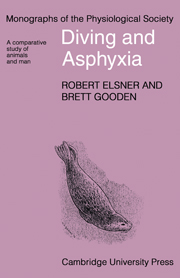3 - Cellular tolerances and adaptations to asphyxia
Published online by Cambridge University Press: 18 May 2010
Summary
About the middle of the last century the younger physiologists broke away from the vitalistic traditions which had been handed down to them, and set about to investigate living organisms piece by piece, precisely as they would investigate the working of a complex mechanism … It is still the orthodox method of physiology, but the old confidence in it has steadily diminished in proportion as exact experimental investigation has shown that the various activities of a living organism cannot be interpreted in isolation from one another, since organic regulation dominates them
(J. S. Haldane, 1922).Survival considerations
Acute but transient loss of function in many structures does not present an irreversible threat to the survival of the animal. Man can withstand temporary loss of function of the kidneys, liver or gut, for example, without placing the survival of the whole body in jeopardy. Similarly, sudden loss of function of one or more limbs is not ordinarily fatal. On the other hand, a sudden, unexpected loss of central nervous function can lead rapidly to an irreversible situation ending in death. Cessation of the normal pumping activity of the heart is rapidly followed by ischaemia and asphyxia of the cerebral tissue with loss of consciousness. Clearly, the heart and brain are the most important tissues for the short-term survival of the organism when faced with the threat of acute asphyxia. Other body tissues are functionally impaired to varying degrees by asphyxia, but they are relatively more resistant to permanent damage.
- Type
- Chapter
- Information
- Diving and AsphyxiaA Comparative Study of Animals and Man, pp. 30 - 59Publisher: Cambridge University PressPrint publication year: 1983



